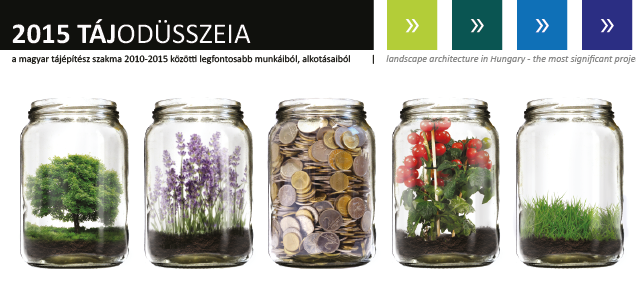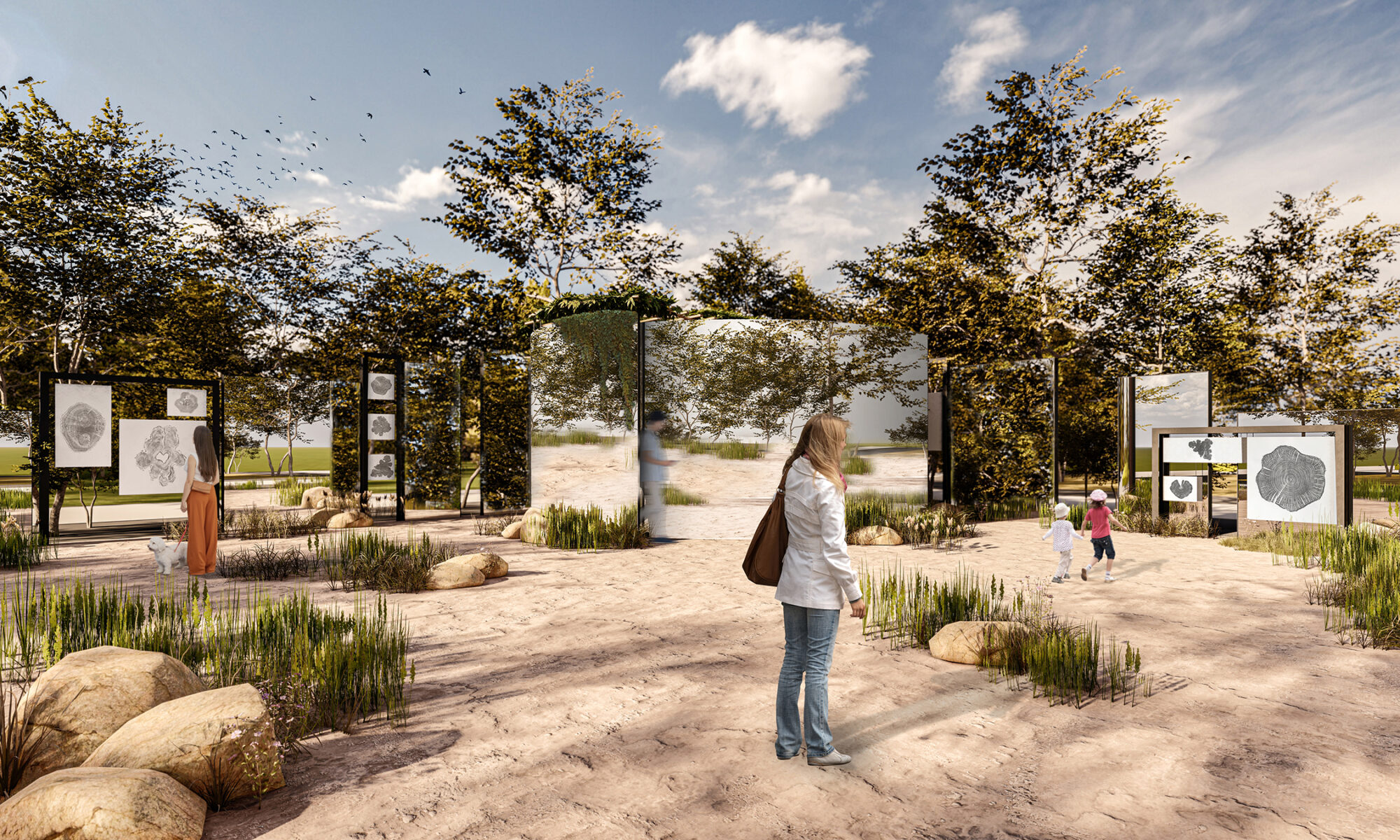Venue: Ponte de Lima – Portugal
Competition: International Garden Festival
Call for entries: 2023.
Organizer: Hungarian Contemporary Architecture Centre
Creators: Ágó Kovács, visual and applied artist
Balázs Almási PhD. landscape designer
Csongor I. Török landscape designer
Edit Pink senior consultant, project manager
Evelin Hajdú landscape designer, garden visual and applied artist
Mercedes Kormos art and design instructor
Monika Kertész curator, funding member of KÉK
Réka Vass student, Moholy-Nagy University of Art and Design
Eternal Echo

The guiding principles of our artwork
An artwork reflects or evokes feelings about things (state, situation, event, etc.). The garden, as a man-made space, is a representation of nature. During the process of creation, a central question we asked ourselves was how art can enhance the function of a garden and how the garden itself can become art. In addition, it was important to keep in mind the ‘identity’ of the recipients (the festival, the visitors/users of the garden), i.e. ‘for whom we are designing’. Through our creation, our artistic expression, we wanted to respond to a problem that was relevant to both local people and the public visiting the exhibition from all over the world.
Design concept and philosophy
We chose garden number 8 as the target area for our garden artwork because of its central location and size. As an installation artwork, the relationship between the inner self and the natural elements is represented through landscape architecture and fine art: actively and passively. The artwork also affects the visitor on an emotional level, reflecting on the global changes in the world around them in a deeper context beyond the triggering of emotions.
On our artwork titled “Eternal Echo”, life and emotions are embodied through the spaces, showing different faces and taking on different qualities.
The mapping consists of three main structural elements:

- The outermost ring is a deserted rim, symbolizing the degradation of relationships and nature.
- The inner ring is the Oasis, life itself, where we can interact directly with nature both physically and visually. The space has
been composed in relation to an attractive central element. The centre symbolises life, strength, potential and a direct
connection with the inner self - The spaces of the parcel are surrounded by a monthly changing wall of space that also functions as a pop-up art exhibition
space, categorised as a peripheral space of encounters due to its interactive and changeable quality.
Climate-adaptive plant application
Climate adaptability is a fundamental requirement in the design of the vegetation of the garden composition. Plant well-being is also an important consideration. With a sustainable approach, we only consider landscape plants that are adapted to the local microclimate and that can be accommodated and continue to survive beyond the exhibition period.
Spatialisation within the installation
The main idea of the concept is to present in an understandable way stylized symbolism: a drastic vision of the future and the will within the individual. As a more distant ideology, the duality of man-made space can be discovered in the design ideology. - The presentation of the extremes in the construction of human-made spaces, in their symbolic and practical connection with nature, and the encouragement of the self, the acting self, to a deep and organic collaboration with our environment.
- The garden itself, as an artistic representation of Nature, is a tribute to the human hand in the environment. It has an effect on the visitor, it gives him/her the space to realise his/her environment, his/her self, and it can also initiate a process of transformation in him/her.
The desert condition is a symbol of human destruction, climate catastrophe, alienation of relationships, loneliness.
The interior space appears as an oasis in the surrounding space depicting the desert, a state of doom. Throughout the space, mirrors and reflective surfaces appear, changing their meaning – and our perception of ourselves – as we move from the outside inwards.
The outer desert ring, sparsely vegetated, reveals an alarming infinity of space, its curved design making us see a curved, distorted mirror before us – which also suggests a cognitive distortion of reality: we are forced to scan our gaze along the path we wish to explore, on ourselves, on others, on the empty sense of existence.
As we approach the interior of the space, the mirror gate opens, and the oasis can be approached through a narrow entrance. The reflective surface in the oasis is a life-giving focal point, a boundary that reinforces mortal humanity: the future is in the hands of the present, which is shaped day by day through our faces and actions. The inner core is a place of calm, a kind of meditative “island of self” where we arrive from the desert of the soul. We can spend time there at our leisure, enjoying its recreational nature.
The oasis welcomes visitors with a colourful, lush interior, full of life, an island of peace and tranquillity. The wood-panelled walls are hung with square mirrors of various sizes, which open up the space to reveal the stimulating vitality of the inner oasis.
The stylized motif of the material with a reflective surface (the Viana heart), which appears as a play of coverings, refers to the creative power of the heart through a symbol that also has a multiple meaning for the people living in this region. The transparent spatial elements are a play of spaces outside the oasis: a space of encounters. The bridging elements between the solitary exterior and the reconciled interior self, symbolizing the eternal and universal role of art in helping the individual to find his/her way in the world around him/her, can also be interpreted as a bridge surface of connection.
Identity formation and art
In addition to the symbolism of life, there is a strong emphasis on the soul: reinforcing the pop-up nature of the garden art vision, elements of the boundary walls follow our walk as a visual art surface.
The exhibition itself lives and changes with the space, with a different artwork being placed on the exhibition surfaces each month, reinforcing the identity of the space being shaped.
In addition, visitors can influence the evolution of the space in two different ways. The first is an interactive game for the public linked to the exterior, the second to the interior. - For the duration of the exhibition, they can take seeds from a storage box in the Oasis and scatter them around the exterior of the installation. By doing so, visitors themselves will influence the present and the future by creating the chance, symbolically and in reality, for a more diverse and greener environment than the one we have now, depending on the weather, the type of seeds, etc.
- In the Oasis, throughout the exhibition, they will be able to place in a message box letters and visions relating to the planned space itself and its concept – or to the ideal future they envision, which will be the final exhibition.
Introduction of the applicant
Hungarian Contemporary Architecture Centre
KÉK is an independent professional institution focusing on architecture, the built environment, urban development and their relation to communities. Due to our unique knowledge, and experience of a decade and a half, and our extended national and international partnership network, our foundation plays a determining role in today’s architecture culture of Central Europe.
Mission
Our cultural programs interpret the architecture and the mechanisms of the city, actively contributing to its innovative improvement with our professional work. Our strength lies in the combination of wide-range participation, complex analysis and innovative content development, simultaneously engaging the professional fields of design, research, and culture.
KÉK is, among others, organising exhibitions, conferences, festivals, trainings, thematic guided tours, professional and public events. Furthermore, we pursue long-term activities such as operating community gardens, analysing and developing urban districts with the involvement of local communities, as well as creating and implementing thematic programs of urban development with our partners involving several cities. The experts of KÉK participate in advisory roles in institutional and urban development programs and architectural projects.
Climate mission
Launching the Community Gardening Project in 2010 KÉK has been engaged in the naturalization and distribution of community gardens. Methodology, legal background and models adaptable to the local environment has been worked out in the Project to provide state-of-the art tools and up-to-date knowledge, information for the movement, which has become mostly self-organized by today in Hungary. Utilizing the experience of past years, the long-term goal of the Project, regarding society and a liveable city, is to introduce and implement different equipment and methods. Through national and international partnerships, we are working to make community gardens an opportunity to educate urban and rural citizens on climate change actions, in addition to their traditional community functions.
Contribution in rural innovations
In recent years, KÉK has also become more active in the field of rural development. As a consortium partner contributed in the Interreg Danube Transnational Programme’s DANUrB (DANube Urban Brand) project (for more information visit:
https://bit.ly/DANUrB) , which aims to strengthen the Danube regional cultural identity and to create a common brand by fostering transnational cultural ties between the settlements along the Danube, and by exploring the unused or hidden cultural and social capital resources for a better economic and cultural return.
In the framework Veszprém-Balaton 2023 European Capital of Culture program TÁJTÉKA – Smart Landscape Management Toolkit on the Balaton Uplands project (for more information visit: https://bit.ly/tajteka_KEK ) takes place on the Balaton Uplands between 2021-2023 The project aims to start a dialogue about the Veszprém and Balaton Uplands region’s intelligent land use. It tries to connect and help stakeholders: local entrepreneurs and residents, newcomers and those arriving with recreational purposes.
Cultural cooperation in Portugal
Reflecting to the topic of sustainable tourism and going around the questions like how we can, as tourists, contribute to the local ecosystem, what strangers can give to the local community KÉK will organize a 3 days community place making series (KÉK Takeover // Sustainable tourism?) in Lisbon on 23-25th of November, 2023.
As newcomers to the city of Lisbon, KÉK aims to redefine the modes of discovering the neighbourhoods around the Palácio Sinel de Cordes – Alfama, Costa do Castelo, and São Vicente – by knocking on many doors during our stay in a literal, explorative and figurative sense. The participatory programme focuses on opening new discussions, presenting good practices and facilitating the co-creation of a sustainable visit through a selection of local initiatives in the field of arts, design and architecture. (More information visit:
https://www.trienaldelisboa.com/programme/events/kek-st)

